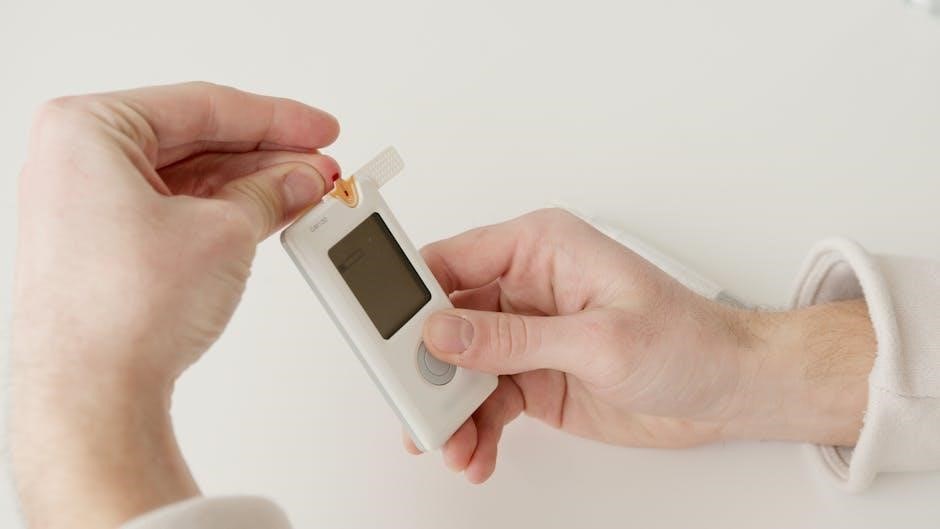A blood sugar log is a tool to track glucose levels, helping manage diabetes effectively. It provides insights into patterns and maintains target ranges, available as PDF templates online.
1.1 What is a Blood Sugar Log?
A blood sugar log is a tool used to record and monitor blood glucose levels, providing a detailed overview of daily readings. It helps individuals with diabetes track their glucose levels at specific times, such as before and after meals, and at bedtime. The log typically includes sections for recording the date, time, blood sugar levels, and additional notes about meals, medications, or physical activity. Available as PDF templates, these logs are customizable to suit individual needs and preferences. Regularly using a blood sugar log allows users to identify patterns, understand how different factors affect their glucose levels, and share valuable data with healthcare providers. This tool is essential for effective diabetes management, helping to maintain target blood sugar ranges and prevent complications. By keeping a consistent record, users can make informed decisions about their diet, exercise, and medication routines.
1.2 Importance of Tracking Blood Sugar Levels
Tracking blood sugar levels is crucial for managing diabetes and preventing complications. By maintaining a blood sugar log, individuals can monitor their glucose readings, identify trends, and make informed decisions about their diet, exercise, and medication. Consistent tracking helps in detecting hyperglycemia and hypoglycemia early, which is vital for preventing long-term health issues such as vision loss, kidney damage, and cardiovascular problems. Additionally, tracking blood sugar levels allows users to understand how different factors like food intake, physical activity, and stress impact their glucose levels. This data is invaluable for healthcare providers, enabling them to adjust treatment plans and ensure optimal care. Regular monitoring also empowers individuals to take control of their health, promoting a proactive approach to managing diabetes and improving overall well-being. A blood sugar log serves as a reliable tool for maintaining health and preventing potential complications.
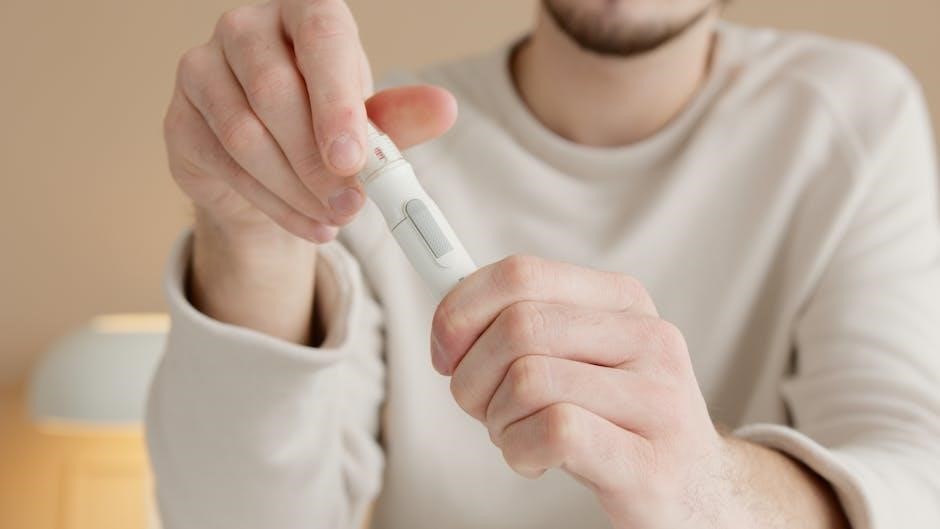
Benefits of Using a Blood Sugar Log
Using a blood sugar log provides better control over glucose levels, improves health outcomes, and helps identify patterns and triggers affecting blood sugar effectively.
2.1 Understanding Blood Sugar Patterns
Tracking blood sugar levels with a log helps identify patterns in glucose fluctuations, enabling individuals to understand how various factors influence their readings. By documenting measurements over time, users can observe trends, such as spikes after specific meals or dips during certain activities. This insights help pinpoint peak times for hyperglycemia or hypoglycemia, aiding in better decision-making. For instance, noticing consistent high morning readings may prompt adjustments in diet, exercise, or medication. Regularly reviewing these patterns fosters a deeper understanding of how lifestyle choices impact blood sugar, empowering individuals to make informed adjustments. Consistent logging also reveals seasonal or cyclic trends, which might otherwise go unnoticed. This data-driven approach supports personalized diabetes management and enhances collaboration with healthcare providers for tailored advice.
2.2 Managing Diet and Nutrition
A blood sugar log PDF is a powerful tool for managing diet and nutrition, helping users track how different foods affect their glucose levels. By recording meals and corresponding blood sugar readings, individuals can identify which foods cause spikes or dips. This data allows for informed decisions about portion sizes, meal timing, and food choices. For example, noticing that high-carb meals lead to elevated readings may prompt a shift toward more balanced or low-carb options. The log also helps monitor the impact of specific nutrients, like fiber or protein, on blood sugar stability. Over time, this information enables the creation of a personalized diet plan that aligns with glucose control goals. Regularly reviewing the log with a healthcare provider further refines dietary strategies, ensuring optimal nutrition and blood sugar management.
2.3 Tracking Medication Effects
A blood sugar log PDF is essential for monitoring how medications impact glucose levels. By recording medication doses alongside blood sugar readings, users can assess the effectiveness of their prescribed treatments. This tool helps identify patterns, such as how insulin or oral medications influence fasting or post-meal glucose levels. Over time, the log reveals whether adjustments to dosage or timing are needed. It also highlights potential side effects, like hypoglycemia, and how they correlate with medication use. Sharing this data with healthcare providers enables informed decisions about treatment plans. For instance, if a medication consistently lowers blood sugar too much, the log serves as evidence for dosage adjustments. This feature makes the blood sugar log a vital resource for optimizing medication regimens and ensuring safe, effective glucose management. Regular reviews of the log ensure medications remain aligned with individual health goals.
2.4 Identifying Triggers and Trends
A blood sugar log PDF helps users pinpoint factors that influence glucose levels, such as food, stress, or physical activity. By documenting daily activities alongside blood sugar readings, individuals can uncover patterns and triggers that cause spikes or dips. For example, certain foods or emotional states may consistently lead to high or low blood sugar. Over time, the log reveals trends, such as elevated levels after specific meals or improved control during periods of regular exercise. This insight allows for proactive adjustments, like modifying diets or stress management routines. Identifying these triggers and trends empowers individuals to make informed decisions, reducing the risk of complications and improving overall glucose management. Regular analysis of the log fosters a deeper understanding of personal health dynamics, enabling tailored strategies for better blood sugar control and long-term wellness.

Types of Blood Sugar Logs
Blood sugar logs are available in various formats, including manual, digital, and PDF. Manual logs are simple and printable, while digital logs offer real-time tracking and sharing capabilities. PDF logs provide customizable templates for easy recording and analysis, making them a popular choice for managing blood sugar levels effectively over time.

3.1 Manual vs. Digital Logs
Manual and digital blood sugar logs differ in their approach to tracking. Manual logs involve writing down readings in a physical notebook or printed PDF template, offering simplicity and portability. They are ideal for those who prefer a tactile method or have limited access to technology. Digital logs, however, use apps or online tools, enabling real-time data entry, automated calculations, and easy sharing with healthcare providers. Digital logs often include features like graphs and reminders, making it easier to identify trends. While manual logs provide privacy and simplicity, digital logs offer convenience and advanced analysis. The choice between the two depends on personal preference, lifestyle, and the need for detailed insights. Both methods are effective for managing blood sugar levels when used consistently.
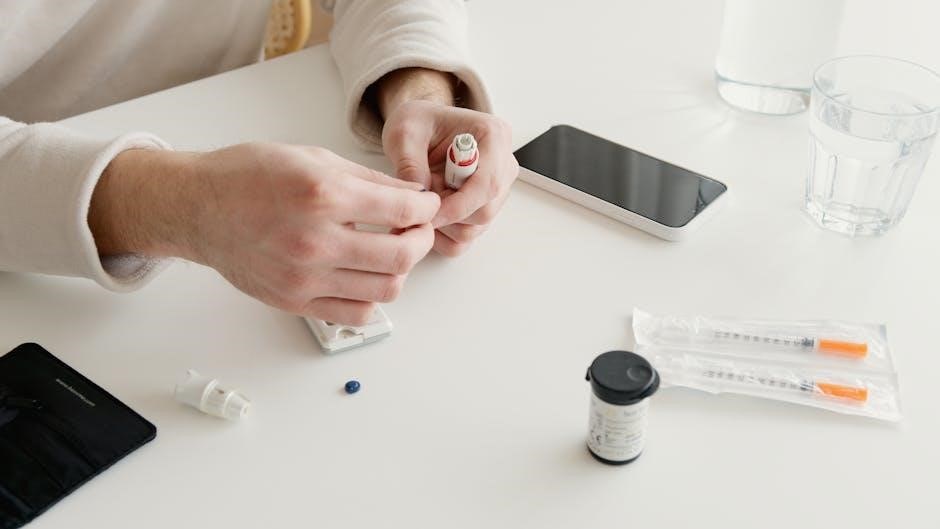
3.2 Features of PDF Blood Sugar Logs
PDF blood sugar logs offer a structured and organized way to track glucose levels. They typically include pre-formatted templates with columns for date, time, blood sugar readings, meals, medication, and notes. This layout ensures consistency and makes it easy to review data over time. Many PDF logs are customizable, allowing users to tailor sections to their specific needs. They are also portable, as they can be printed or saved digitally for easy access. PDF logs are universally compatible with most devices and software, making them a versatile option. Additionally, they provide a clear and professional format for sharing with healthcare providers. Some PDF logs include graphs or charts to visualize trends, while others offer space for daily reflections or goals. Overall, PDF blood sugar logs combine simplicity with essential features, making them a practical tool for effective blood sugar management.

How to Create a Blood Sugar Log
To create a blood sugar log, include time, date, readings, and notes. Use a clear, organized format with grids or tables for easy data entry and tracking progress.
4.1 Essential Elements to Include
When creating a blood sugar log, it is crucial to include key elements that provide a comprehensive overview of your glucose levels and related factors. Start by documenting the date and time of each reading, as timing plays a significant role in blood sugar fluctuations. Next, record your fasting blood sugar levels and postprandial (after meal) readings to track changes. Note the type and dosage of medications taken, as well as any insulin administered. Include details about meals consumed, such as portion sizes, carbohydrate counts, and food types, to identify dietary impacts. Physical activity levels and any symptoms experienced, like hypoglycemia or hyperglycemia, should also be logged. Finally, add notes about unusual events, stress, or illness that might influence blood sugar levels. These elements help identify patterns, guide treatment adjustments, and improve overall blood sugar management.
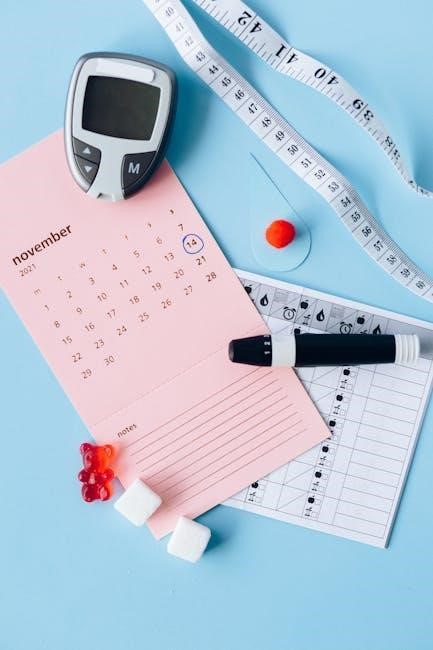
4.2 Designing a Custom Blood Sugar Log
Designing a custom blood sugar log allows you to tailor it to your specific needs, ensuring it is both functional and easy to use. Start by determining the layout, whether it will be digital or printed. Include sections for blood sugar readings, meal details, and medication doses. Add columns for notes to track factors like exercise, stress, or sleep. Consider using color coding or symbols to highlight trends or important entries. For digital logs, use templates or design tools to create a clean, organized format. Ensure the log is easy to edit and update, with clear headings and ample space for writing. Customize the log to reflect your personal goals, such as weight management or specific health targets. A well-designed log will make tracking easier and more effective, helping you stay on top of your blood sugar management.
4.3 Where to Find Blood Sugar Log Templates
Blood sugar log templates are widely available online, making it easy to find one that suits your needs. Official health websites, such as those from the American Diabetes Association or the Centers for Disease Control and Prevention, often provide free downloadable templates. Microsoft Office and Google Sheets also offer customizable templates that you can edit to fit your preferences. Additionally, platforms like Pinterest and Etsy have a variety of blood sugar log templates, including printable PDFs and digital formats. Some websites specialize in medical templates, offering tailored designs for blood sugar tracking. When searching, use keywords like “blood sugar log PDF” or “diabetes log templates” to find relevant options. Choose a template that aligns with your tracking goals and is easy to use for consistent monitoring.

Using Your Blood Sugar Log Effectively
Effectively using your blood sugar log involves consistent tracking, identifying trends, and adjusting your diet or medication as needed. Regular monitoring helps maintain better blood sugar control.
5.1 How to Fill Out Your Blood Sugar Log
To fill out your blood sugar log effectively, start by recording the date and time of each reading. Note your blood sugar levels before and after meals, as this helps track how food affects your glucose. Include the type and portion of meals consumed, along with any medications taken and their doses. Physical activity, such as exercise, should also be documented, as it impacts blood sugar levels. Add any symptoms experienced, like dizziness or fatigue, to provide context for fluctuations. Be consistent and accurate in your entries, as this data is crucial for identifying patterns. Regularly reviewing your log can help you and your healthcare provider make informed decisions about your diabetes management plan.
- Record date, time, and blood sugar levels.
- Document meals, medications, and physical activity.
- Note any symptoms or unusual patterns.
- Review the log regularly for insights.
5.2 Establishing a Routine for Monitoring
Establishing a consistent monitoring routine is key to effectively managing blood sugar levels. Set specific times each day to check your glucose, such as upon waking, before meals, and before bed. Use your blood sugar log to track these readings, ensuring you follow the same schedule daily. This routine helps identify patterns and prevents fluctuations. Include notes about meals, medications, and physical activity to gain a comprehensive understanding of your glucose levels. Aim to test at the same times each day, such as fasting in the morning and 2 hours after meals. Consistency allows you to spot trends and make necessary adjustments. By sticking to a routine, you can better manage your blood sugar and maintain healthy levels over time.
- Set specific times for daily glucose checks.
- Include notes on meals, medications, and activities.
- Consistency helps identify patterns and trends.
- Regular monitoring improves blood sugar control.
5.3 Reviewing and Analyzing Your Data
Regularly reviewing and analyzing your blood sugar log data is crucial for understanding your glucose trends and making informed decisions. Take time each week to look for patterns, such as high or low glucose levels at specific times of the day. Identify any recurring spikes or dips and determine their possible causes, such as diet, stress, or medication changes. Highlighting these trends can help you adjust your treatment plan effectively. Use the insights gained to refine your diet, exercise, or medication schedule. Sharing this data with your healthcare provider ensures personalized advice and better blood sugar management. By regularly analyzing your log, you can achieve tighter glucose control and improve your overall health outcomes.
- Review data weekly to spot trends and patterns.
- Identify causes of glucose spikes or dips.
- Adjust treatment plans based on insights.
- Share findings with healthcare providers for guidance.

5.4 Sharing Your Log with Healthcare Providers
Sharing your blood sugar log with healthcare providers is essential for optimizing your diabetes management plan. Your log provides detailed insights into your glucose levels, helping your doctor understand patterns, trends, and the effectiveness of your current treatment. Regularly sharing this data ensures personalized recommendations and timely adjustments to medication, diet, or exercise routines. Before appointments, organize your log by date and highlight key trends or unusual readings. This preparation allows your healthcare team to focus on critical areas and provide actionable advice. By maintaining open communication and sharing your log, you empower your healthcare providers to support your journey toward better blood sugar control and overall wellness.
- Provide detailed insights into glucose trends.
- Enable personalized treatment adjustments.
- Highlight key trends for discussion.
- Enhance communication with healthcare teams.
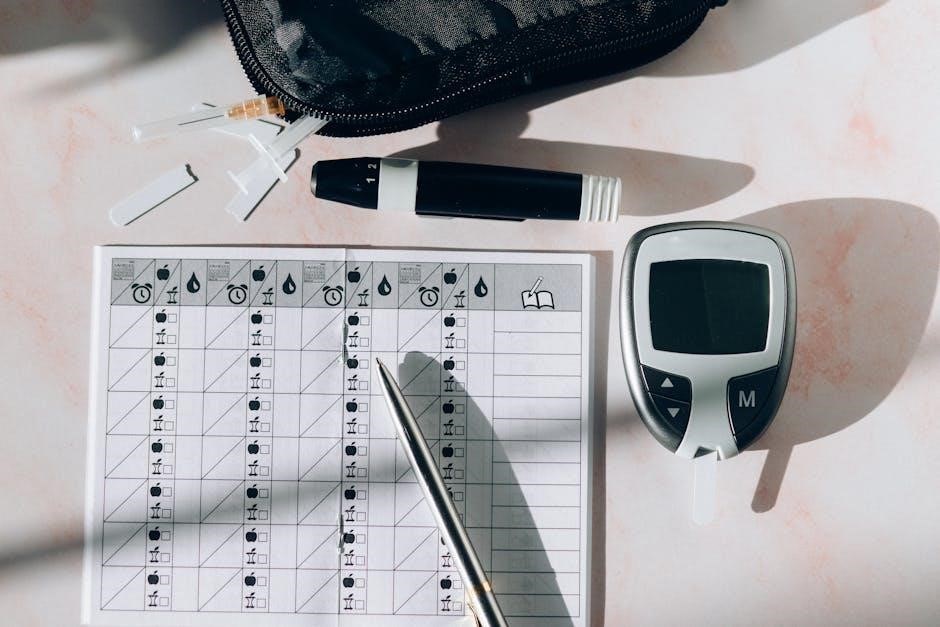
Additional Resources for Blood Sugar Management
Explore free PDF templates and apps designed for blood sugar tracking. Utilize detailed guides and tools to manage and analyze your logs effectively for better diabetes control.
- Free downloadable PDF templates
- Apps with PDF export features
- Comprehensive user guides
6.1 Free Printable Blood Sugar Log Templates
Free printable blood sugar log templates are widely available online, offering a convenient way to track glucose levels. These templates are designed to be easy to use and customizable, allowing users to monitor their blood sugar readings, note medications, and record meals or physical activities. Many templates are available in PDF format, making them easy to download and print. They often include spaces for morning and evening readings, as well as sections for notes or comments. Websites like official health organizations and diabetes management platforms provide these templates for free. Using a printable blood sugar log PDF ensures that users can keep track of their health data without relying on digital tools. These templates are perfect for individuals who prefer a hands-on approach to managing their blood sugar levels and sharing records with healthcare providers.
6.2 Recommended Platforms for Blood Sugar Tracking
Several digital platforms are available to help users effectively track their blood sugar levels. MySugr and Glucose Buddy are popular apps that allow users to log readings, set reminders, and analyze trends. These platforms often sync with wearable devices, making it easy to monitor glucose levels in real-time. Websites like Diabetes Connect also offer tools for tracking blood sugar, medications, and meals. Many platforms provide customizable dashboards and detailed reports, enabling users to identify patterns and share data with healthcare providers; Additionally, platforms like MyNetDiary offer comprehensive tracking features tailored for diabetes management. These tools are invaluable for individuals seeking to maintain better control over their blood sugar levels and improve overall health outcomes. By leveraging these platforms, users can simplify the process of monitoring and managing their glucose data efficiently.
Consistent blood sugar monitoring is a cornerstone of effective diabetes management. By regularly tracking glucose levels, individuals can gain insights into how diet, exercise, and medications impact their health. Blood sugar logs, whether in PDF or digital formats, serve as invaluable tools for identifying patterns and making informed decisions. Over time, this data helps individuals and healthcare providers adjust treatment plans to achieve better glucose control. Regular monitoring also reduces the risk of complications associated with diabetes, such as nerve damage or vision problems; Ultimately, maintaining a blood sugar log fosters accountability and empowers individuals to take charge of their health. By prioritizing consistent monitoring, people with diabetes can lead healthier, more balanced lives.
